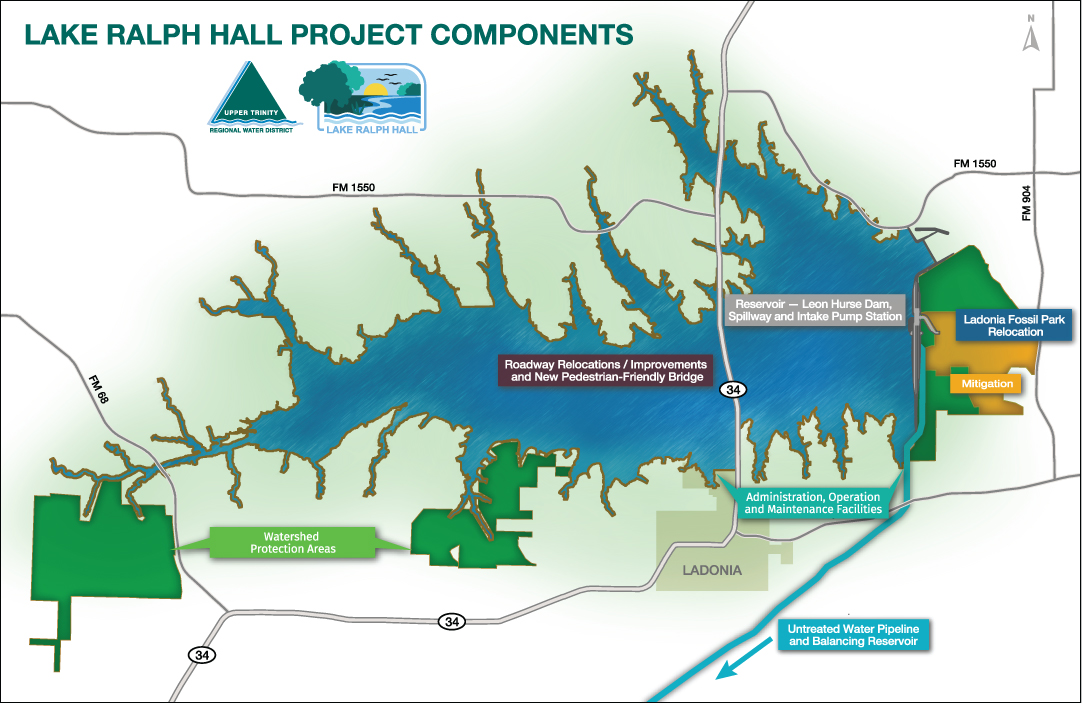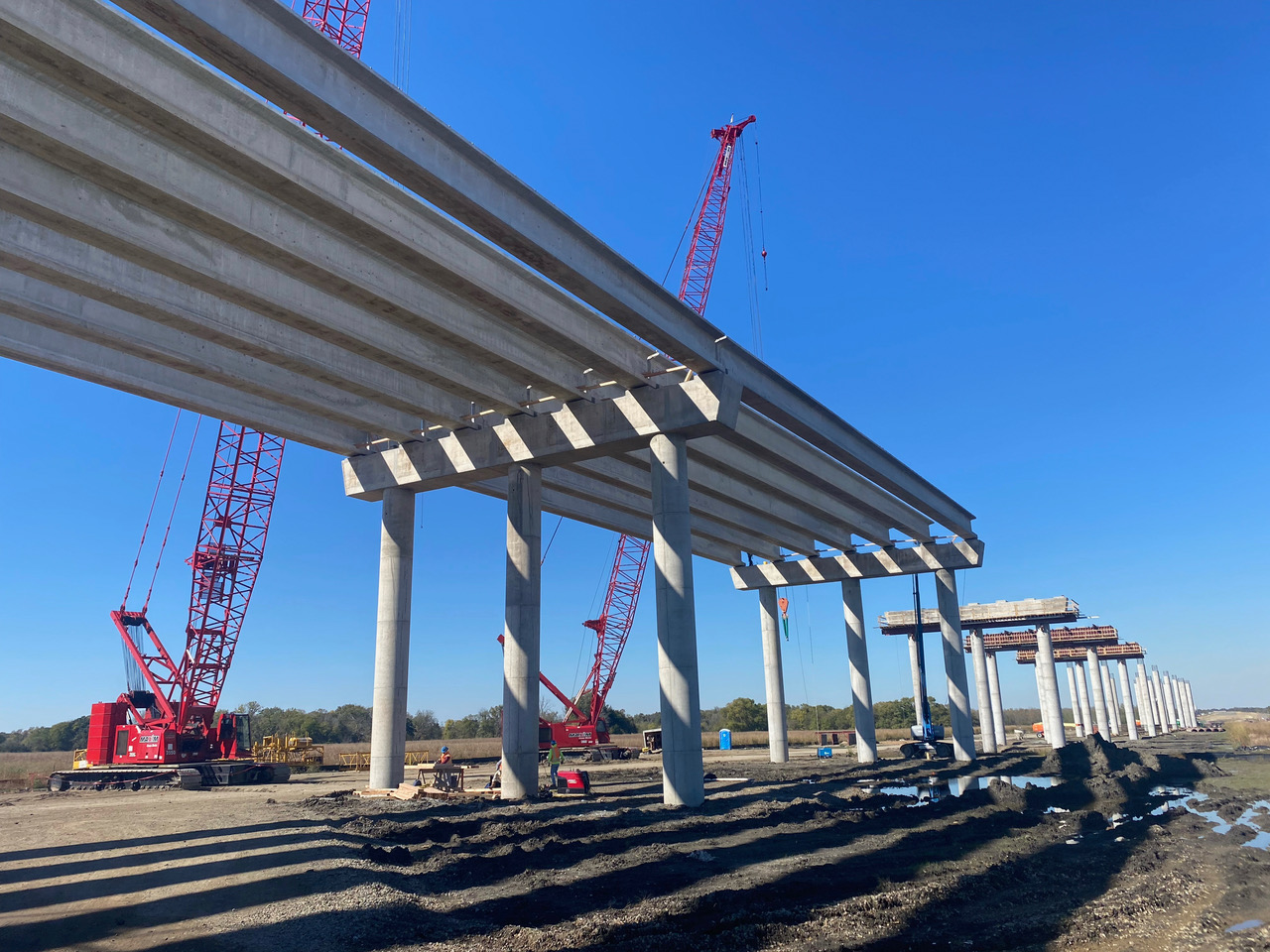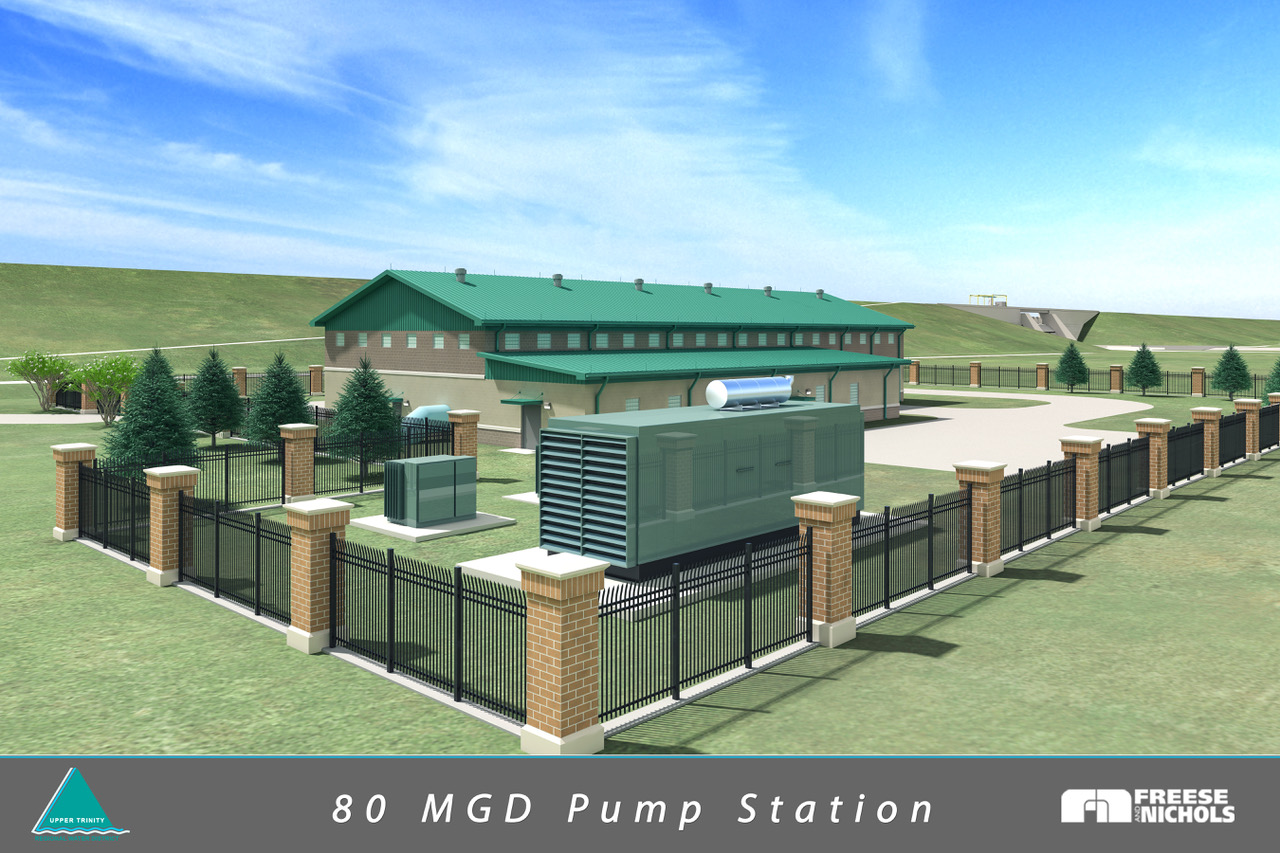By Robert L. Reid
Although the Upper Trinity Regional Water District in Denton County, Texas, just north of Dallas, currently enjoys a roughly 8,000 acre ft surplus annually of drinking water, the county is growing quickly and would likely lose that water surplus by 2025 — if not for the district’s long-term planning, says Edward M. Motley, P.E., M.ASCE, the program manager of the district’s Lake Ralph Hall reservoir project. But thanks to the district’s foresight, which included starting plans for a new reservoir more than 20 years ago, the residents of Denton and nearby Collin and Fannin counties will have access by 2026 to an estimated 185,000 acre ft of new water storage in Lake Ralph Hall, yielding about 39,000 acre ft per year of new supply, Motley explains.
Located in Fannin County, about 80 mi east of the Denton region, Lake Ralph Hall will be just the second major new reservoir constructed in Texas over the past 30 years or so. The other, Bois d’Arc Lake, is also located in Fannin County and expected to become fully operational sometime next year.
Fulfilling multiple needs
Named for a longtime member of the U.S. House of Representatives, Ralph Moody Hall, the reservoir project broke ground in July 2021. It will inundate an area of roughly 7,600 acres near the city of Ladonia by constructing a dam across a portion of the North Sulphur River.

Ladonia’s city leaders envisioned the lake project more than 30 years ago as a means of local economic development, “so we partnered with them and fulfilled both our needs,” says Motley.
Creating a new water supply such as Lake Ralph Hall involves a number of elements, notes Motley. The program includes a new dam, named after a longtime mayor of Ladonia, Leon Hurse, who was “an early visionary for the lake project,” Motley notes. And there will also be roadway and utility relocations, lake maintenance and administration facilities, and clearing and demolition within the reservoir footprint.
Water from the lake will be conveyed to the district’s service area. To that end, the district is partnering with the city of Irving, one of its members, to leverage excess capacity in an existing pipeline to convey the water. But the connection to Irving’s system also requires a new 32 mi long pipeline, a pump station, and a balancing reservoir.
Gathering the team
Freese and Nichols, of Fort Worth, Texas, is designing the Leon Hurse Dam, which will be a roughly 2.3 mi long, 108 ft tall earthen structure. The dam will also feature a 705 ft long, 104 ft high concrete spillway; a raw water intake structure; and a pump station. The dam will be built by Granite Construction, of Watsonville, California.
Lockwood, Andrews & Newnam, of Houston, is serving as the general engineering consultant for the conveyance system, coordinating the efforts of the pipeline designers, Overland Park, Kansas-based Black & Veatch and Dallas-based Jacobs; the pump station designer, Freese and Nichols; the pump station construction manager at risk, the Irving office of Archer Western; and a pipeline construction manager at risk, which the district is currently selecting, Motley says.
The district chose to deliver the roadway relocations, including a roughly 1 mi long bridge to carry State Highway 34 across the new lake, using the progressive design-build model. Although this model has been used in the water industry in Texas for some time, it is the district’s first design-build project and the first progressive design-build project for a Texas Department of Transportation project, Motley notes.

“Given our limited background on transportation projects, the district felt like the progressive design-build model gave us the best chance to manage our risk on that particular component,” says Motley. The district selected Flatiron Construction Corp., of San Marcos, Texas, as the roadway design-builder; Dallas-based Huitt-Zollars will assist Flatiron as its design subcontractor. Lamb-Star, of Plano, Texas, will support the district as the roadway construction engineering and inspection team.
The district is in the process of selecting a firm to design and construct aquatic mitigation efforts through a full-service provider contract, Motley says; Richardson, Texas-based Halff Associates will design the lake maintenance and administration facilities.
CH2M Hill worked on planning and permit support before becoming part of Jacobs, which also serves as the roadway relocations owner-engineer and reservoir demolition and clearing designer and will provide program management support. Fort Worth-based Plummer Associates and Ecosystems Planning and Restoration, of Tomball, Texas, assisted the district in the development of the aquatic resources mitigation plan. Kleinfelder, based in San Diego, is responsible for the project’s quality assurance.
Building in a great place
At the start of the Lake Ralph Hall reservoir project, more than 20 structures remained on the site, which had largely been used as open farmland. But over the years, as land was acquired for the reservoir project, residents moved away and buildings were demolished.
Because the poorly drained river resulted in frequent flooding, the site was not ideal for raising crops or livestock. But the soil conditions included a 30 to 40 ft thick layer of clay atop an impervious bedrock, making it “a great place for a lake,” Motley explains.
The Leon Hurse Dam will be oriented north-south and feature a roller-compacted concrete and cast-in-place concrete spillway, a 1,700 ft wide excavated earthen emergency spillway, and a 120 ft wide labyrinth weir overflow section, according to information Freese and Nichols provided to Civil Engineering. The cast-in-place concrete pump station intake structure will feature stainless steel screens, a series of nine stainless steel sluice gates (each measuring 7 ft by 7 ft), painted steel stop logs, and a vertical lift bridge crane.
The raw water intake and pump station facilities are still being designed but will feature an intake tower on the upstream face of the dam, two 84 in. diameter pipes and a 60 in. diameter pipe extending through the dam, and a 31 ft tall cast-in-place concrete valve vault structure partially buried near the dam’s downstream toe. At the vault, the 84 in. pipes will connect to 72 in. diameter pipes to access the pump station. The 60 in. pipe will connect to the spillway stilling basin to the north.

The raw water pump station will use horizontal split case pumping units. It is being designed for an initial capacity of 55 mgd with the ability for the station to be expanded to an 80 mgd capacity.
Reaching out, meeting requirements
State and federal regulatory and permitting requirements mean projects such as Lake Ralph Hall take decades to complete, says Motley. For example, a water rights application — to allow the project to divert water from the North Sulphur River — was submitted to the Texas Commission on Environmental Quality in 2003 but was not granted until 2013. Even then, the project faced an additional legal challenge from groups opposed to the plan before the application was finally upheld by a Texas appellate court, Motley says.
Likewise, the project team filed an application with the U.S. Army Corps of Engineers for a permit under Section 404 of the federal Clean Water Act in 2006 but did not receive that permit until 2020, following extensive reviews, documentation of the potential environmental impacts, and development of mitigation plans to address those impacts, Motley explains.
Both permitting processes also involved extensive public involvement and outreach to numerous stakeholders, he adds. The project team worked closely with the U.S. Environmental Protection Agency, the U.S. Fish and Wildlife Service, the U.S. Forest Service, and the Texas Parks and Wildlife Department as well as various local county and municipal governments.
The district was also required by state and federal regulators to restore degraded streams downstream of the proposed lake to mitigate the reservoir’s aquatic impacts. And the district is still in the process of addressing cultural resource requirements, which it is doing with support from AR Consultants Inc., of Richardson.
“Cultural resources is our last major regulatory hurdle,” says Motley. The project team even worked with the Dallas Paleontological Society to relocate an existing fossil park to a new site that features the same geological conditions, Motley notes. And Dallas’ Perot Museum of Nature and Science is a consultant that will assist the project if paleontological resources are uncovered during excavations.



